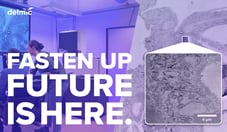As the field of artificial intelligence (AI) and machine learning (ML) rapidly evolves, their applications and potential benefits grow across various industries and fields. One field that can greatly benefit from AI and ML is the field of life sciences, where researchers are performing a lot of manual and time-consuming tasks in their experiments and work with ever-increasingly large datasets [1].
By integrating AI and ML into life science research, simple manual tasks can be automated, and large datasets can be analyzed more easily, making research more efficient. This holds the potential to advance our understanding of healthy and diseased cells and tissues and may lead to faster and more cost-effective drug development [2].
However, the successful integration of computational and life science communities requires effective communication and collaboration to bridge the gap between these two fields. In recent years, communication platforms have emerged as tools for making connections and collaborations between life science researchers and computational scientists. Below, we will discuss three community platforms: AI4Life, NEUBIAS, and The Big Picture Project.
AI and ML for bioimage analysis
Bioimage analysis requires a lot of manual steps that can be automated, such as image stitching, object segmentation, and subsequent quantitative analysis. Automation in these processes also provides life science researchers with more quantitative insights. To address this, community platforms have primarily focussed on the use of AI and ML algorithms for bioimage analysis in life science research.
One notable platform is Artificial Intelligence for Life (AI4Life) [3]. This community-driven platform aims to facilitate collaboration between computational and life science communities. It’s a Europe-funded project that empowers life science researchers with AI and ML methods for bioimage analysis. AI4Life offers an open and accessible repository for life scientists called BioImage Model Zoo [4]. This repository serves as a centralized platform for the latest AI models, list datasets, and other essential tools. Additionally, AI4Life provides open calls and direct user support to assist life scientists. They also offer courses on data analysis and deep learning for image analysis.
Another community platform for bioimage analysis is the Network of European BioImage Analysts (NEUBIAS) [5]. This European network of bioimage analysts aims to bridge the gap between life science, computer science, and digital image processing. Their primary objective is to establish the role of bioimage analysts in life science research. NEUBIAS organizes international conferences and training on bioimage analysis, as well as so-called ‘taggathons’. In these taggathons, participants collaboratively ‘tag’ information, such as bioimage analysis algorithms and workflows, into an easily accessible online repository for the community. Additionally, they offer resources such as a ‘Scientific Community Image’ Forum and ‘Call 4 Help’, an online community that can help you with your bioimage analysis problems.
AI for pathology research
The Big Picture Project is a community-driven platform that started in 2021 with the goal of bringing together quality-controlled annotated pathology images and AI algorithms [6]. Its primary objective is to build a large repository of digital pathology slides for artificial intelligence development. To achieve this, the project connects pathologists, researchers, AI developers, patients, and industry partners. Currently, they have 45 partners, including academic institutions, public organizations, pharmaceutical companies, and contributors of images. Alongside building the repository, they organize annual consortium meetings, host webinars, and podcasts, and provide regular updates on their milestones.
The integration of AI and ML into life science research presents great potential for revolutionizing the field of life science. Community platforms such as NEUBIAS, AI4Life, and The Big Picture Project play a crucial role in connecting life science researchers and AI scientists, enabling interdisciplinary collaborations, knowledge sharing, and collective problem-solving. How would you as a life science researcher use these community platforms to your advantage?
References
[1] Noorbakhsh-Sabet, N. et al., The American Journal of Medicine 132, 7, 795-801 (2019)
[2] Alimadadi, A. et al., Physiological Genomics 52, 4, 200-202 (2020)
[3] AI4Life community platform
[4] BioImage Model Zoo repository
[5] NEUBIAS community platform
[6] The Big Picture Project
.png)









